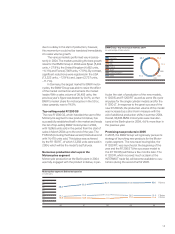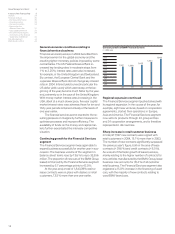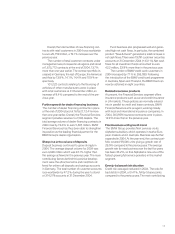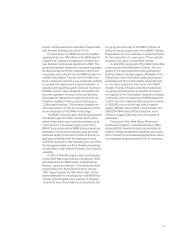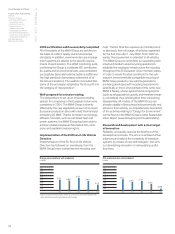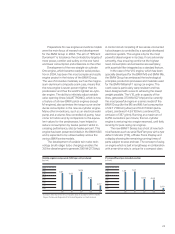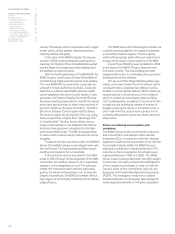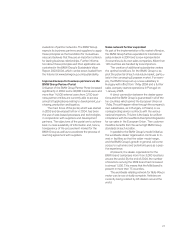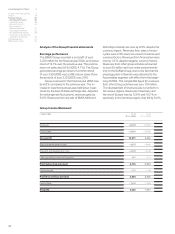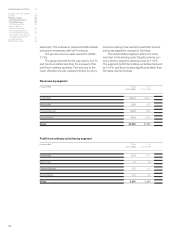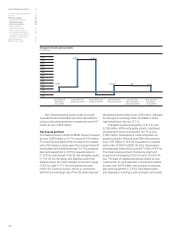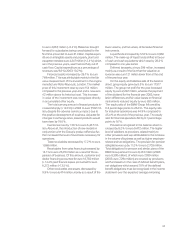BMW 2004 Annual Report Download - page 26
Download and view the complete annual report
Please find page 26 of the 2004 BMW annual report below. You can navigate through the pages in the report by either clicking on the pages listed below, or by using the keyword search tool below to find specific information within the annual report.
25
to a 25% reduction in consumption for the period
from1995 to 2008.
As well as optimising existing engine technolo-
gies and introducing new model series such as the
BMW 1 Series in autumn 2004, the long-term aim
is to use alternative fuels to propel motor vehicles.
A version with a hydrogen-powered engine will be
delivered to customers during the production phase
of the current BMW 7 Series. The objective of BMW
CleanEnergy, an initiative of the BMW Group, is
the use of hydrogen, which can be produced
on the
basis of renewable or CO
2
-free energy sources
and
which therefore offers the greatest potential for
reducing CO2levels and preserving fossil fuel re-
sources. The potential of hydrogen technology has
been demonstrated by the record-breaking hydrogen
vehicle, the BMW H2R, which set nine international
records in 2004.
International purchasing network strengthened
The BMW Group further expanded its international
purchasing network in 2004 and, in conjunction with
the production of the 3 Series and 5 Series at the
Shenyang plant, began to take advantage of the
potential offered by the procurement markets in
China and the ASEAN region (Association of South
East Asian Nations) for car body and chassis parts.
As part of the process of global growth, the BMW
Group is focusing its product-related procurement
market strategies mainly on the NAFTA (North
American Free Trade Agreement) region, but also
on Asia, and in particular, China. In addition to re-
ducing currency exposures, the main aim is to secure
supplies to the plants at optimal cost.
Lower volume of purchases in the NAFTA
region due to currency factors
An analysis of the regional split of the supply of parts
to the global production network shows that the
BMW Group continues to purchase almost one half
of all bought-in items outside Germany.
The volume of purchases in Germany and
Western Europe (euro region) increased at a more
pronounced rate that elsewhere as a result of the
higher volume of MINI brand cars sold and the start
of production of the BMW 1Series. The proportion
of total purchases accounted for by Germany and
Western Europe (excluding Germany) increased by
90
*The adoption of the uniform VDA computation method for measurement in accordance with the DIN-1/3-Mix (up to 1996) and the New European Driving Cycle
(from1997 onwards) gives rise to minor variances compared to earlier BMW Group annual reports.
91 92 93 94 95 96 97 98 99 00 01 02 03 04
100.0 97.5
90.9 89.3
85.8 83.7 86.3 87.3 85.6
79.6
74.0
74.3 74.0
77.3
Fuel consumption of BMW Group cars
(Index:1990 =100; Basis: fleet consumption of newly registered cars measured on the basis of the New European Driving Cycle in accordance with the VDA
commitment for passenger/estate cars*)
110
105
100
95
90
85
80
75
70
65
82.1


